Project Planning and Communications: Vitragroup Facade Panel Project
VerifiedAdded on 2023/06/07
|14
|3584
|429
Project
AI Summary
This project plan details the development of a new facade panel product by Vitragroup, a major manufacturer of commercial facade panels. The project addresses the need for a safer material to replace polyethylene core aluminium panels, following the Grenfell Tower fire. The plan outlines the use of 3D printing for rapid prototyping and focuses on key aspects like quality control, work breakdown structure, time and resource optimization, and method selection. The report includes a company profile, project deliverables, outputs, and outcomes, emphasizing the importance of safety, quality, and customer-centric design. The project's budget, scheduled to begin on October 1, 2018, involves rigorous testing, and aims for mass production with close collaboration with customers. The plan highlights the advantages of 3D printing and addresses its limitations. The project also includes a detailed resource definition table and emphasizes the importance of adhering to building codes and quality standards. The project aims to develop a safe, durable, and high-quality facade panel that meets and exceeds the requirements of the Building Code Australia Standards.
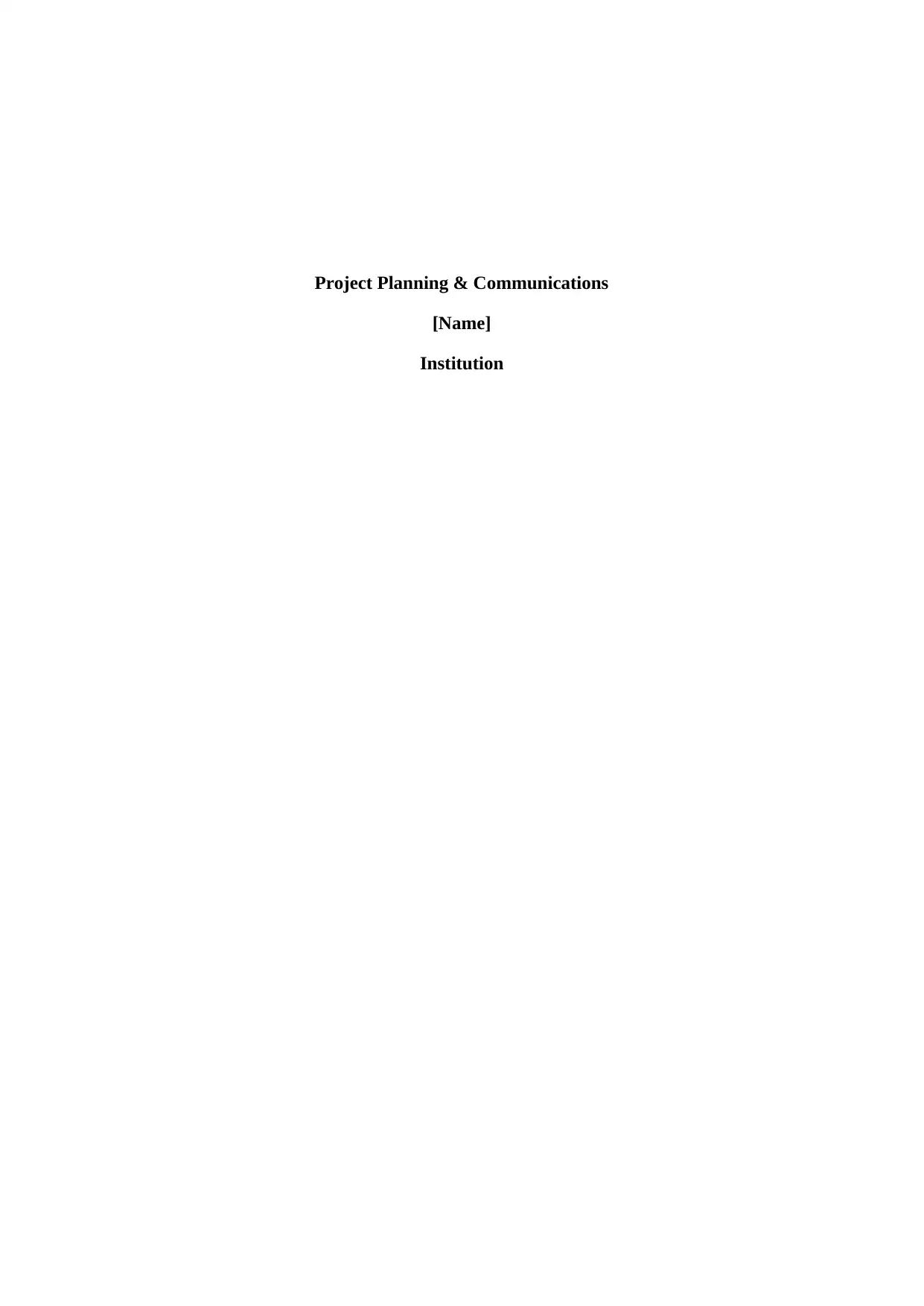
Project Planning & Communications
[Name]
Institution
[Name]
Institution
Paraphrase This Document
Need a fresh take? Get an instant paraphrase of this document with our AI Paraphraser
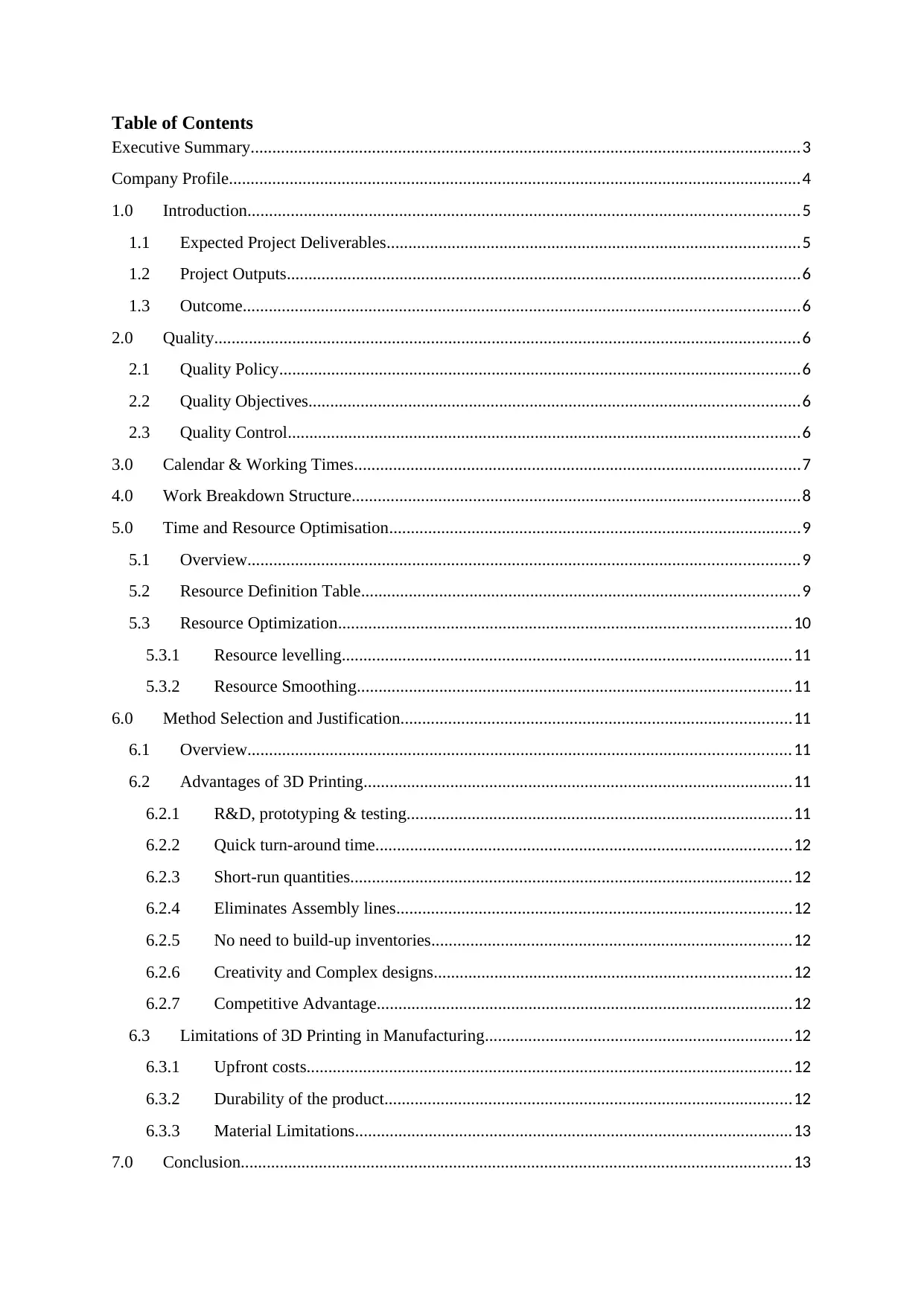
Table of Contents
Executive Summary...............................................................................................................................3
Company Profile....................................................................................................................................4
1.0 Introduction...............................................................................................................................5
1.1 Expected Project Deliverables...............................................................................................5
1.2 Project Outputs......................................................................................................................6
1.3 Outcome................................................................................................................................6
2.0 Quality.......................................................................................................................................6
2.1 Quality Policy........................................................................................................................6
2.2 Quality Objectives.................................................................................................................6
2.3 Quality Control......................................................................................................................6
3.0 Calendar & Working Times.......................................................................................................7
4.0 Work Breakdown Structure.......................................................................................................8
5.0 Time and Resource Optimisation...............................................................................................9
5.1 Overview...............................................................................................................................9
5.2 Resource Definition Table.....................................................................................................9
5.3 Resource Optimization........................................................................................................10
5.3.1 Resource levelling........................................................................................................11
5.3.2 Resource Smoothing....................................................................................................11
6.0 Method Selection and Justification..........................................................................................11
6.1 Overview.............................................................................................................................11
6.2 Advantages of 3D Printing...................................................................................................11
6.2.1 R&D, prototyping & testing.........................................................................................11
6.2.2 Quick turn-around time................................................................................................12
6.2.3 Short-run quantities......................................................................................................12
6.2.4 Eliminates Assembly lines...........................................................................................12
6.2.5 No need to build-up inventories...................................................................................12
6.2.6 Creativity and Complex designs..................................................................................12
6.2.7 Competitive Advantage................................................................................................12
6.3 Limitations of 3D Printing in Manufacturing.......................................................................12
6.3.1 Upfront costs................................................................................................................12
6.3.2 Durability of the product..............................................................................................12
6.3.3 Material Limitations.....................................................................................................13
7.0 Conclusion...............................................................................................................................13
Executive Summary...............................................................................................................................3
Company Profile....................................................................................................................................4
1.0 Introduction...............................................................................................................................5
1.1 Expected Project Deliverables...............................................................................................5
1.2 Project Outputs......................................................................................................................6
1.3 Outcome................................................................................................................................6
2.0 Quality.......................................................................................................................................6
2.1 Quality Policy........................................................................................................................6
2.2 Quality Objectives.................................................................................................................6
2.3 Quality Control......................................................................................................................6
3.0 Calendar & Working Times.......................................................................................................7
4.0 Work Breakdown Structure.......................................................................................................8
5.0 Time and Resource Optimisation...............................................................................................9
5.1 Overview...............................................................................................................................9
5.2 Resource Definition Table.....................................................................................................9
5.3 Resource Optimization........................................................................................................10
5.3.1 Resource levelling........................................................................................................11
5.3.2 Resource Smoothing....................................................................................................11
6.0 Method Selection and Justification..........................................................................................11
6.1 Overview.............................................................................................................................11
6.2 Advantages of 3D Printing...................................................................................................11
6.2.1 R&D, prototyping & testing.........................................................................................11
6.2.2 Quick turn-around time................................................................................................12
6.2.3 Short-run quantities......................................................................................................12
6.2.4 Eliminates Assembly lines...........................................................................................12
6.2.5 No need to build-up inventories...................................................................................12
6.2.6 Creativity and Complex designs..................................................................................12
6.2.7 Competitive Advantage................................................................................................12
6.3 Limitations of 3D Printing in Manufacturing.......................................................................12
6.3.1 Upfront costs................................................................................................................12
6.3.2 Durability of the product..............................................................................................12
6.3.3 Material Limitations.....................................................................................................13
7.0 Conclusion...............................................................................................................................13

References...........................................................................................................................................14
Executive Summary
This report presents a summary of project planning, scheduling, resource allocation and
budgeting for a product development project. The project intends to design and prototype a
new facade panel product using new safer material, to replace the banned use of polyethylene
core aluminium panels.
The proposed method of use is 3D printing, to take advantage of its rapid prototyping
approach. The choice of 3D printing is based on the fact that prototyping can be very quick
due to the quick turnaround time of the technology.
Executive Summary
This report presents a summary of project planning, scheduling, resource allocation and
budgeting for a product development project. The project intends to design and prototype a
new facade panel product using new safer material, to replace the banned use of polyethylene
core aluminium panels.
The proposed method of use is 3D printing, to take advantage of its rapid prototyping
approach. The choice of 3D printing is based on the fact that prototyping can be very quick
due to the quick turnaround time of the technology.
⊘ This is a preview!⊘
Do you want full access?
Subscribe today to unlock all pages.

Trusted by 1+ million students worldwide
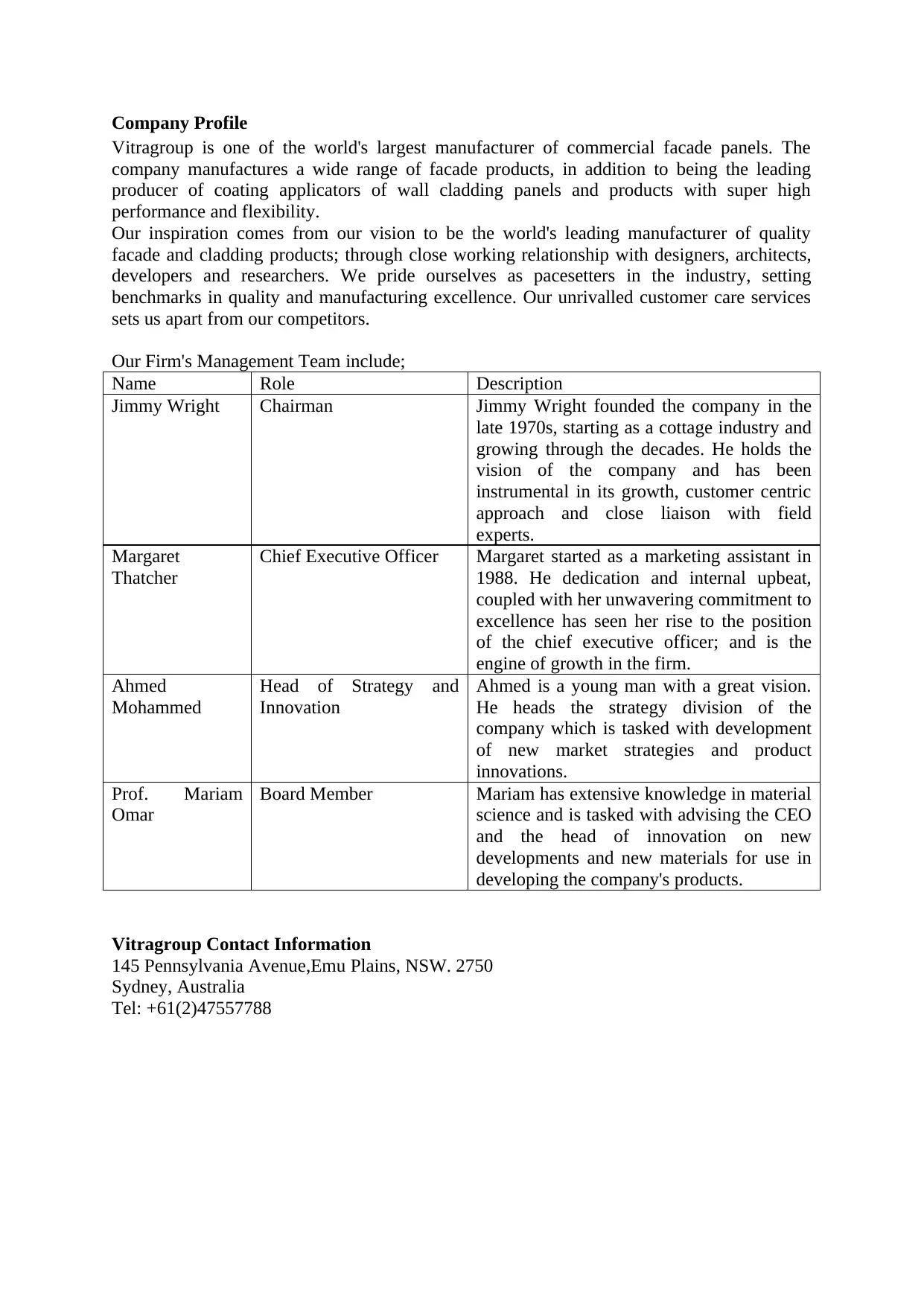
Company Profile
Vitragroup is one of the world's largest manufacturer of commercial facade panels. The
company manufactures a wide range of facade products, in addition to being the leading
producer of coating applicators of wall cladding panels and products with super high
performance and flexibility.
Our inspiration comes from our vision to be the world's leading manufacturer of quality
facade and cladding products; through close working relationship with designers, architects,
developers and researchers. We pride ourselves as pacesetters in the industry, setting
benchmarks in quality and manufacturing excellence. Our unrivalled customer care services
sets us apart from our competitors.
Our Firm's Management Team include;
Name Role Description
Jimmy Wright Chairman Jimmy Wright founded the company in the
late 1970s, starting as a cottage industry and
growing through the decades. He holds the
vision of the company and has been
instrumental in its growth, customer centric
approach and close liaison with field
experts.
Margaret
Thatcher
Chief Executive Officer Margaret started as a marketing assistant in
1988. He dedication and internal upbeat,
coupled with her unwavering commitment to
excellence has seen her rise to the position
of the chief executive officer; and is the
engine of growth in the firm.
Ahmed
Mohammed
Head of Strategy and
Innovation
Ahmed is a young man with a great vision.
He heads the strategy division of the
company which is tasked with development
of new market strategies and product
innovations.
Prof. Mariam
Omar
Board Member Mariam has extensive knowledge in material
science and is tasked with advising the CEO
and the head of innovation on new
developments and new materials for use in
developing the company's products.
Vitragroup Contact Information
145 Pennsylvania Avenue,Emu Plains, NSW. 2750
Sydney, Australia
Tel: +61(2)47557788
Vitragroup is one of the world's largest manufacturer of commercial facade panels. The
company manufactures a wide range of facade products, in addition to being the leading
producer of coating applicators of wall cladding panels and products with super high
performance and flexibility.
Our inspiration comes from our vision to be the world's leading manufacturer of quality
facade and cladding products; through close working relationship with designers, architects,
developers and researchers. We pride ourselves as pacesetters in the industry, setting
benchmarks in quality and manufacturing excellence. Our unrivalled customer care services
sets us apart from our competitors.
Our Firm's Management Team include;
Name Role Description
Jimmy Wright Chairman Jimmy Wright founded the company in the
late 1970s, starting as a cottage industry and
growing through the decades. He holds the
vision of the company and has been
instrumental in its growth, customer centric
approach and close liaison with field
experts.
Margaret
Thatcher
Chief Executive Officer Margaret started as a marketing assistant in
1988. He dedication and internal upbeat,
coupled with her unwavering commitment to
excellence has seen her rise to the position
of the chief executive officer; and is the
engine of growth in the firm.
Ahmed
Mohammed
Head of Strategy and
Innovation
Ahmed is a young man with a great vision.
He heads the strategy division of the
company which is tasked with development
of new market strategies and product
innovations.
Prof. Mariam
Omar
Board Member Mariam has extensive knowledge in material
science and is tasked with advising the CEO
and the head of innovation on new
developments and new materials for use in
developing the company's products.
Vitragroup Contact Information
145 Pennsylvania Avenue,Emu Plains, NSW. 2750
Sydney, Australia
Tel: +61(2)47557788
Paraphrase This Document
Need a fresh take? Get an instant paraphrase of this document with our AI Paraphraser
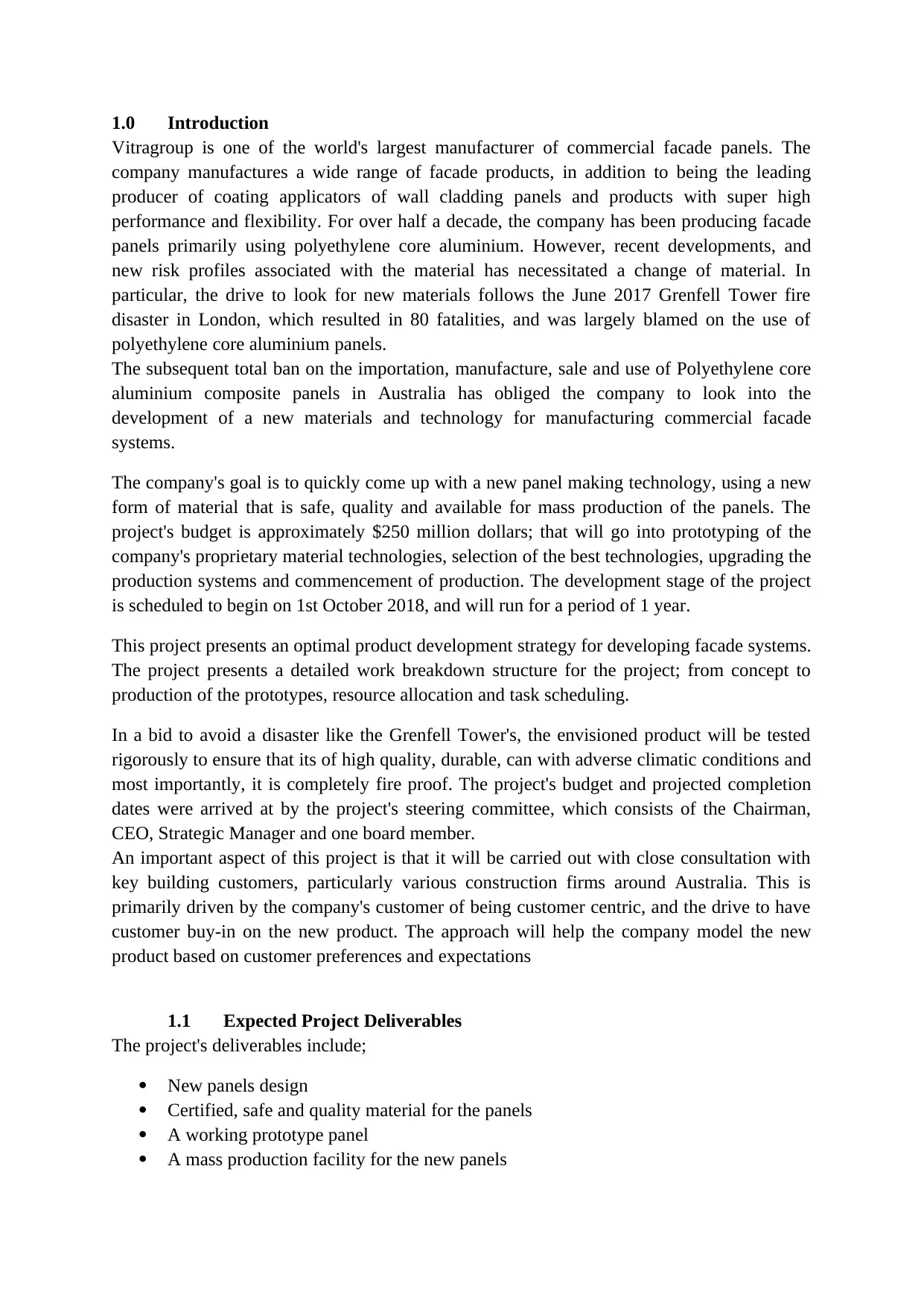
1.0 Introduction
Vitragroup is one of the world's largest manufacturer of commercial facade panels. The
company manufactures a wide range of facade products, in addition to being the leading
producer of coating applicators of wall cladding panels and products with super high
performance and flexibility. For over half a decade, the company has been producing facade
panels primarily using polyethylene core aluminium. However, recent developments, and
new risk profiles associated with the material has necessitated a change of material. In
particular, the drive to look for new materials follows the June 2017 Grenfell Tower fire
disaster in London, which resulted in 80 fatalities, and was largely blamed on the use of
polyethylene core aluminium panels.
The subsequent total ban on the importation, manufacture, sale and use of Polyethylene core
aluminium composite panels in Australia has obliged the company to look into the
development of a new materials and technology for manufacturing commercial facade
systems.
The company's goal is to quickly come up with a new panel making technology, using a new
form of material that is safe, quality and available for mass production of the panels. The
project's budget is approximately $250 million dollars; that will go into prototyping of the
company's proprietary material technologies, selection of the best technologies, upgrading the
production systems and commencement of production. The development stage of the project
is scheduled to begin on 1st October 2018, and will run for a period of 1 year.
This project presents an optimal product development strategy for developing facade systems.
The project presents a detailed work breakdown structure for the project; from concept to
production of the prototypes, resource allocation and task scheduling.
In a bid to avoid a disaster like the Grenfell Tower's, the envisioned product will be tested
rigorously to ensure that its of high quality, durable, can with adverse climatic conditions and
most importantly, it is completely fire proof. The project's budget and projected completion
dates were arrived at by the project's steering committee, which consists of the Chairman,
CEO, Strategic Manager and one board member.
An important aspect of this project is that it will be carried out with close consultation with
key building customers, particularly various construction firms around Australia. This is
primarily driven by the company's customer of being customer centric, and the drive to have
customer buy-in on the new product. The approach will help the company model the new
product based on customer preferences and expectations
1.1 Expected Project Deliverables
The project's deliverables include;
New panels design
Certified, safe and quality material for the panels
A working prototype panel
A mass production facility for the new panels
Vitragroup is one of the world's largest manufacturer of commercial facade panels. The
company manufactures a wide range of facade products, in addition to being the leading
producer of coating applicators of wall cladding panels and products with super high
performance and flexibility. For over half a decade, the company has been producing facade
panels primarily using polyethylene core aluminium. However, recent developments, and
new risk profiles associated with the material has necessitated a change of material. In
particular, the drive to look for new materials follows the June 2017 Grenfell Tower fire
disaster in London, which resulted in 80 fatalities, and was largely blamed on the use of
polyethylene core aluminium panels.
The subsequent total ban on the importation, manufacture, sale and use of Polyethylene core
aluminium composite panels in Australia has obliged the company to look into the
development of a new materials and technology for manufacturing commercial facade
systems.
The company's goal is to quickly come up with a new panel making technology, using a new
form of material that is safe, quality and available for mass production of the panels. The
project's budget is approximately $250 million dollars; that will go into prototyping of the
company's proprietary material technologies, selection of the best technologies, upgrading the
production systems and commencement of production. The development stage of the project
is scheduled to begin on 1st October 2018, and will run for a period of 1 year.
This project presents an optimal product development strategy for developing facade systems.
The project presents a detailed work breakdown structure for the project; from concept to
production of the prototypes, resource allocation and task scheduling.
In a bid to avoid a disaster like the Grenfell Tower's, the envisioned product will be tested
rigorously to ensure that its of high quality, durable, can with adverse climatic conditions and
most importantly, it is completely fire proof. The project's budget and projected completion
dates were arrived at by the project's steering committee, which consists of the Chairman,
CEO, Strategic Manager and one board member.
An important aspect of this project is that it will be carried out with close consultation with
key building customers, particularly various construction firms around Australia. This is
primarily driven by the company's customer of being customer centric, and the drive to have
customer buy-in on the new product. The approach will help the company model the new
product based on customer preferences and expectations
1.1 Expected Project Deliverables
The project's deliverables include;
New panels design
Certified, safe and quality material for the panels
A working prototype panel
A mass production facility for the new panels
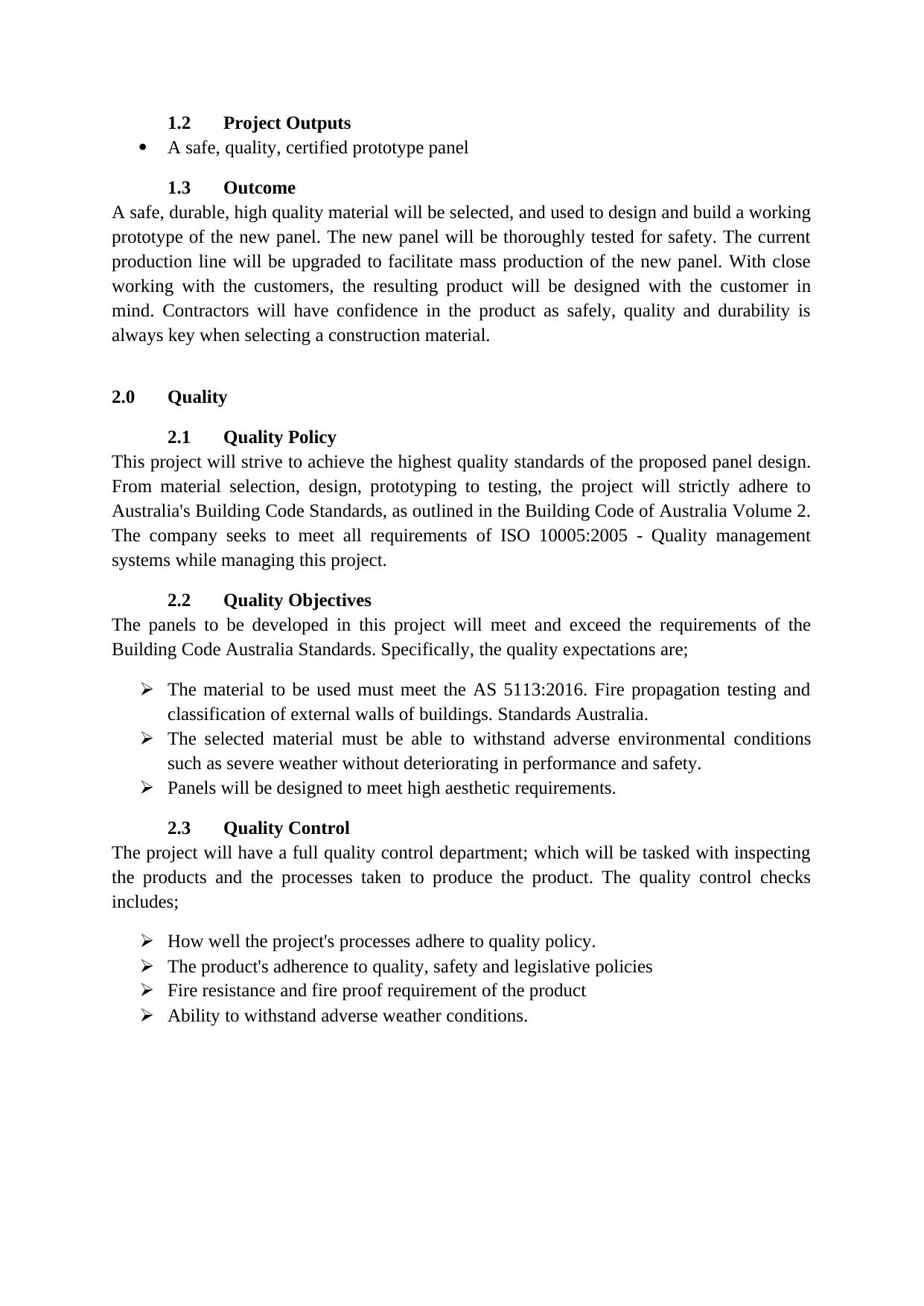
1.2 Project Outputs
A safe, quality, certified prototype panel
1.3 Outcome
A safe, durable, high quality material will be selected, and used to design and build a working
prototype of the new panel. The new panel will be thoroughly tested for safety. The current
production line will be upgraded to facilitate mass production of the new panel. With close
working with the customers, the resulting product will be designed with the customer in
mind. Contractors will have confidence in the product as safely, quality and durability is
always key when selecting a construction material.
2.0 Quality
2.1 Quality Policy
This project will strive to achieve the highest quality standards of the proposed panel design.
From material selection, design, prototyping to testing, the project will strictly adhere to
Australia's Building Code Standards, as outlined in the Building Code of Australia Volume 2.
The company seeks to meet all requirements of ISO 10005:2005 - Quality management
systems while managing this project.
2.2 Quality Objectives
The panels to be developed in this project will meet and exceed the requirements of the
Building Code Australia Standards. Specifically, the quality expectations are;
The material to be used must meet the AS 5113:2016. Fire propagation testing and
classification of external walls of buildings. Standards Australia.
The selected material must be able to withstand adverse environmental conditions
such as severe weather without deteriorating in performance and safety.
Panels will be designed to meet high aesthetic requirements.
2.3 Quality Control
The project will have a full quality control department; which will be tasked with inspecting
the products and the processes taken to produce the product. The quality control checks
includes;
How well the project's processes adhere to quality policy.
The product's adherence to quality, safety and legislative policies
Fire resistance and fire proof requirement of the product
Ability to withstand adverse weather conditions.
A safe, quality, certified prototype panel
1.3 Outcome
A safe, durable, high quality material will be selected, and used to design and build a working
prototype of the new panel. The new panel will be thoroughly tested for safety. The current
production line will be upgraded to facilitate mass production of the new panel. With close
working with the customers, the resulting product will be designed with the customer in
mind. Contractors will have confidence in the product as safely, quality and durability is
always key when selecting a construction material.
2.0 Quality
2.1 Quality Policy
This project will strive to achieve the highest quality standards of the proposed panel design.
From material selection, design, prototyping to testing, the project will strictly adhere to
Australia's Building Code Standards, as outlined in the Building Code of Australia Volume 2.
The company seeks to meet all requirements of ISO 10005:2005 - Quality management
systems while managing this project.
2.2 Quality Objectives
The panels to be developed in this project will meet and exceed the requirements of the
Building Code Australia Standards. Specifically, the quality expectations are;
The material to be used must meet the AS 5113:2016. Fire propagation testing and
classification of external walls of buildings. Standards Australia.
The selected material must be able to withstand adverse environmental conditions
such as severe weather without deteriorating in performance and safety.
Panels will be designed to meet high aesthetic requirements.
2.3 Quality Control
The project will have a full quality control department; which will be tasked with inspecting
the products and the processes taken to produce the product. The quality control checks
includes;
How well the project's processes adhere to quality policy.
The product's adherence to quality, safety and legislative policies
Fire resistance and fire proof requirement of the product
Ability to withstand adverse weather conditions.
⊘ This is a preview!⊘
Do you want full access?
Subscribe today to unlock all pages.

Trusted by 1+ million students worldwide

3.0 Calendar & Working Times
The project's calendar will have a five day week, 8working hours running from 8am to 5pm;
with a 1 hour lunch break. The project team will therefore work for 40hours per month. All
public holidays will not be off the project's working days.
Figure 1.0 Project Creation in Primavera P6
Figure 2.0 Project Start date configuration
The project's calendar will have a five day week, 8working hours running from 8am to 5pm;
with a 1 hour lunch break. The project team will therefore work for 40hours per month. All
public holidays will not be off the project's working days.
Figure 1.0 Project Creation in Primavera P6
Figure 2.0 Project Start date configuration
Paraphrase This Document
Need a fresh take? Get an instant paraphrase of this document with our AI Paraphraser

4.0 Work Breakdown Structure
In order to develop a work breakdown structure, a task list has to be developed. For this
project, the method of choice to translate concept to prototype is 3D printing, which has most
of its tasks fully automated. The overall task list for the project will be broken down into 6
broad categories, and each category will have its sub-categories or work-packages
For this project, the main task will be concept development and refinement. For any product
to be produced, a concept has to be developed. Concept development will require engineers,
designers to brainstorm and select materials that can be used in the development of the
product. The selected material will have to be sourced before manufacturing can start.
Sourcing for the materials and design work will be done concurrently.
In order to develop a work breakdown structure, a task list has to be developed. For this
project, the method of choice to translate concept to prototype is 3D printing, which has most
of its tasks fully automated. The overall task list for the project will be broken down into 6
broad categories, and each category will have its sub-categories or work-packages
For this project, the main task will be concept development and refinement. For any product
to be produced, a concept has to be developed. Concept development will require engineers,
designers to brainstorm and select materials that can be used in the development of the
product. The selected material will have to be sourced before manufacturing can start.
Sourcing for the materials and design work will be done concurrently.

5.0 Time and Resource Optimisation
5.1 Overview
With the total ban on the importation, manufacture, sale and use of Polyethylene core
aluminium composite panels in Australia having taken place already, the company is behind
schedule in coming up with a new product design, that uses a different kind of safer material.
5.1 Overview
With the total ban on the importation, manufacture, sale and use of Polyethylene core
aluminium composite panels in Australia having taken place already, the company is behind
schedule in coming up with a new product design, that uses a different kind of safer material.
⊘ This is a preview!⊘
Do you want full access?
Subscribe today to unlock all pages.

Trusted by 1+ million students worldwide

Developing this product is therefore a matter of survival for the company. Speedy completion
of the project is therefore a matter of essence. For that reason, the project seeks to optimize
time and resources, in order to remain competitive in the market with introduction of a new
safer product.
5.2 Resource Definition Table
This table outlines key resources to be used in this project.
Resource Description
Company Chairman The company chairman will act as the project sponsor. He will be part
of the steering committee that will make critical decisions about the
project; such as schedule changes, cost adjustments and approving
change requests.
Chief Executive Officer The chief executive office is the customer in this project. As part of
the steering committee, the CEO will take part in approving or
disallowing change requests, adjusting project funding and project
schedule.
Project Manager The project manager will play a critical role of day-to-day
management of the project. The PM will organize the project team,
assign roles to the team, develop the project schedule and be the
liaison officer between the project team and the management.
Product Dev manager The project development manager will be part of the project team,
tasked with the concept development, material selection and concept
refinement.
Engineer The engineer will be part of the project team, and will participate in
concept development, analysis of the designs as well as play part in
quality inspection of the developed prototype.
Designer The designer is a CAD specialist, tasked with the design work,
implementation of the design in CAD and assisting other project team
members in analysing the designs. The designer will work closely
with the engineer and the product development manager to develop,
analyse and refine the product concept.
Quality Control Inspector The Quality control inspector will be tasked with inspecting the
project processes, materials, designs and the resulting prototype to
ensure that they are of high quality, safe and adheres to legal
requirements, the companies quality policies and any other national
and international policy that relates to the building codes.
Production Manager The production manager will oversee the implementation of the
prototype. The manager will be tasked with all activities relating to the
translation of the design to a prototype at the factory.
Factory floor manager The floor manager is responsible for managing factory workers who
will play part in handling materials and providing support to the other
team members wherever they may be needed.
Factory workers Handle materials and providing support to the other team members
wherever they may be needed.
Procurement Office The procurement officer will - in consultation with the engineer and
the product development team - make plans to acquire all materials
that will be required in this project.
Truck Trucks will be used to transport materials to the site; by using the
company's own trucks, the cost of the project is expected to be sliced
of the project is therefore a matter of essence. For that reason, the project seeks to optimize
time and resources, in order to remain competitive in the market with introduction of a new
safer product.
5.2 Resource Definition Table
This table outlines key resources to be used in this project.
Resource Description
Company Chairman The company chairman will act as the project sponsor. He will be part
of the steering committee that will make critical decisions about the
project; such as schedule changes, cost adjustments and approving
change requests.
Chief Executive Officer The chief executive office is the customer in this project. As part of
the steering committee, the CEO will take part in approving or
disallowing change requests, adjusting project funding and project
schedule.
Project Manager The project manager will play a critical role of day-to-day
management of the project. The PM will organize the project team,
assign roles to the team, develop the project schedule and be the
liaison officer between the project team and the management.
Product Dev manager The project development manager will be part of the project team,
tasked with the concept development, material selection and concept
refinement.
Engineer The engineer will be part of the project team, and will participate in
concept development, analysis of the designs as well as play part in
quality inspection of the developed prototype.
Designer The designer is a CAD specialist, tasked with the design work,
implementation of the design in CAD and assisting other project team
members in analysing the designs. The designer will work closely
with the engineer and the product development manager to develop,
analyse and refine the product concept.
Quality Control Inspector The Quality control inspector will be tasked with inspecting the
project processes, materials, designs and the resulting prototype to
ensure that they are of high quality, safe and adheres to legal
requirements, the companies quality policies and any other national
and international policy that relates to the building codes.
Production Manager The production manager will oversee the implementation of the
prototype. The manager will be tasked with all activities relating to the
translation of the design to a prototype at the factory.
Factory floor manager The floor manager is responsible for managing factory workers who
will play part in handling materials and providing support to the other
team members wherever they may be needed.
Factory workers Handle materials and providing support to the other team members
wherever they may be needed.
Procurement Office The procurement officer will - in consultation with the engineer and
the product development team - make plans to acquire all materials
that will be required in this project.
Truck Trucks will be used to transport materials to the site; by using the
company's own trucks, the cost of the project is expected to be sliced
Paraphrase This Document
Need a fresh take? Get an instant paraphrase of this document with our AI Paraphraser
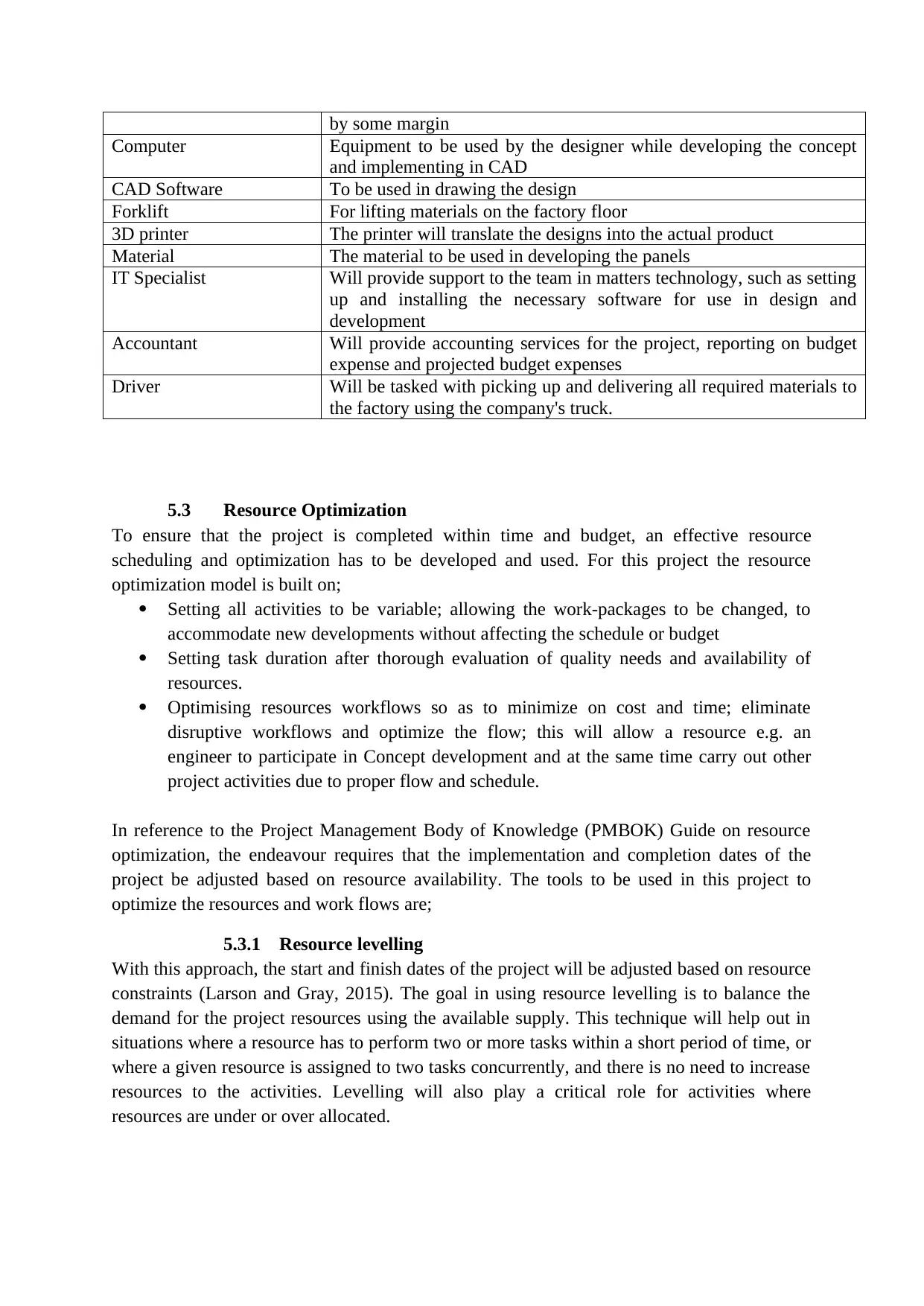
by some margin
Computer Equipment to be used by the designer while developing the concept
and implementing in CAD
CAD Software To be used in drawing the design
Forklift For lifting materials on the factory floor
3D printer The printer will translate the designs into the actual product
Material The material to be used in developing the panels
IT Specialist Will provide support to the team in matters technology, such as setting
up and installing the necessary software for use in design and
development
Accountant Will provide accounting services for the project, reporting on budget
expense and projected budget expenses
Driver Will be tasked with picking up and delivering all required materials to
the factory using the company's truck.
5.3 Resource Optimization
To ensure that the project is completed within time and budget, an effective resource
scheduling and optimization has to be developed and used. For this project the resource
optimization model is built on;
Setting all activities to be variable; allowing the work-packages to be changed, to
accommodate new developments without affecting the schedule or budget
Setting task duration after thorough evaluation of quality needs and availability of
resources.
Optimising resources workflows so as to minimize on cost and time; eliminate
disruptive workflows and optimize the flow; this will allow a resource e.g. an
engineer to participate in Concept development and at the same time carry out other
project activities due to proper flow and schedule.
In reference to the Project Management Body of Knowledge (PMBOK) Guide on resource
optimization, the endeavour requires that the implementation and completion dates of the
project be adjusted based on resource availability. The tools to be used in this project to
optimize the resources and work flows are;
5.3.1 Resource levelling
With this approach, the start and finish dates of the project will be adjusted based on resource
constraints (Larson and Gray, 2015). The goal in using resource levelling is to balance the
demand for the project resources using the available supply. This technique will help out in
situations where a resource has to perform two or more tasks within a short period of time, or
where a given resource is assigned to two tasks concurrently, and there is no need to increase
resources to the activities. Levelling will also play a critical role for activities where
resources are under or over allocated.
Computer Equipment to be used by the designer while developing the concept
and implementing in CAD
CAD Software To be used in drawing the design
Forklift For lifting materials on the factory floor
3D printer The printer will translate the designs into the actual product
Material The material to be used in developing the panels
IT Specialist Will provide support to the team in matters technology, such as setting
up and installing the necessary software for use in design and
development
Accountant Will provide accounting services for the project, reporting on budget
expense and projected budget expenses
Driver Will be tasked with picking up and delivering all required materials to
the factory using the company's truck.
5.3 Resource Optimization
To ensure that the project is completed within time and budget, an effective resource
scheduling and optimization has to be developed and used. For this project the resource
optimization model is built on;
Setting all activities to be variable; allowing the work-packages to be changed, to
accommodate new developments without affecting the schedule or budget
Setting task duration after thorough evaluation of quality needs and availability of
resources.
Optimising resources workflows so as to minimize on cost and time; eliminate
disruptive workflows and optimize the flow; this will allow a resource e.g. an
engineer to participate in Concept development and at the same time carry out other
project activities due to proper flow and schedule.
In reference to the Project Management Body of Knowledge (PMBOK) Guide on resource
optimization, the endeavour requires that the implementation and completion dates of the
project be adjusted based on resource availability. The tools to be used in this project to
optimize the resources and work flows are;
5.3.1 Resource levelling
With this approach, the start and finish dates of the project will be adjusted based on resource
constraints (Larson and Gray, 2015). The goal in using resource levelling is to balance the
demand for the project resources using the available supply. This technique will help out in
situations where a resource has to perform two or more tasks within a short period of time, or
where a given resource is assigned to two tasks concurrently, and there is no need to increase
resources to the activities. Levelling will also play a critical role for activities where
resources are under or over allocated.
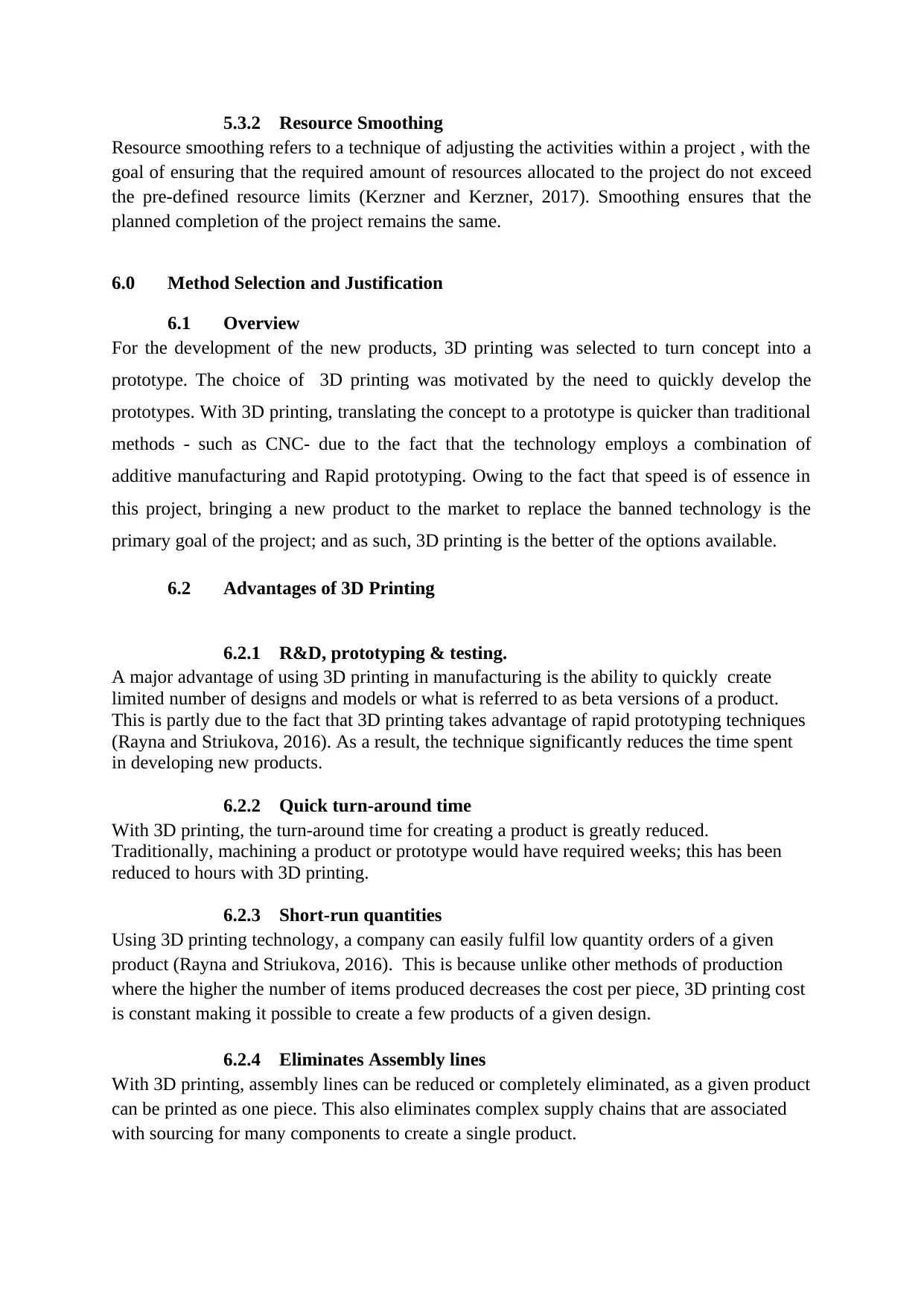
5.3.2 Resource Smoothing
Resource smoothing refers to a technique of adjusting the activities within a project , with the
goal of ensuring that the required amount of resources allocated to the project do not exceed
the pre-defined resource limits (Kerzner and Kerzner, 2017). Smoothing ensures that the
planned completion of the project remains the same.
6.0 Method Selection and Justification
6.1 Overview
For the development of the new products, 3D printing was selected to turn concept into a
prototype. The choice of 3D printing was motivated by the need to quickly develop the
prototypes. With 3D printing, translating the concept to a prototype is quicker than traditional
methods - such as CNC- due to the fact that the technology employs a combination of
additive manufacturing and Rapid prototyping. Owing to the fact that speed is of essence in
this project, bringing a new product to the market to replace the banned technology is the
primary goal of the project; and as such, 3D printing is the better of the options available.
6.2 Advantages of 3D Printing
6.2.1 R&D, prototyping & testing.
A major advantage of using 3D printing in manufacturing is the ability to quickly create
limited number of designs and models or what is referred to as beta versions of a product.
This is partly due to the fact that 3D printing takes advantage of rapid prototyping techniques
(Rayna and Striukova, 2016). As a result, the technique significantly reduces the time spent
in developing new products.
6.2.2 Quick turn-around time
With 3D printing, the turn-around time for creating a product is greatly reduced.
Traditionally, machining a product or prototype would have required weeks; this has been
reduced to hours with 3D printing.
6.2.3 Short-run quantities
Using 3D printing technology, a company can easily fulfil low quantity orders of a given
product (Rayna and Striukova, 2016). This is because unlike other methods of production
where the higher the number of items produced decreases the cost per piece, 3D printing cost
is constant making it possible to create a few products of a given design.
6.2.4 Eliminates Assembly lines
With 3D printing, assembly lines can be reduced or completely eliminated, as a given product
can be printed as one piece. This also eliminates complex supply chains that are associated
with sourcing for many components to create a single product.
Resource smoothing refers to a technique of adjusting the activities within a project , with the
goal of ensuring that the required amount of resources allocated to the project do not exceed
the pre-defined resource limits (Kerzner and Kerzner, 2017). Smoothing ensures that the
planned completion of the project remains the same.
6.0 Method Selection and Justification
6.1 Overview
For the development of the new products, 3D printing was selected to turn concept into a
prototype. The choice of 3D printing was motivated by the need to quickly develop the
prototypes. With 3D printing, translating the concept to a prototype is quicker than traditional
methods - such as CNC- due to the fact that the technology employs a combination of
additive manufacturing and Rapid prototyping. Owing to the fact that speed is of essence in
this project, bringing a new product to the market to replace the banned technology is the
primary goal of the project; and as such, 3D printing is the better of the options available.
6.2 Advantages of 3D Printing
6.2.1 R&D, prototyping & testing.
A major advantage of using 3D printing in manufacturing is the ability to quickly create
limited number of designs and models or what is referred to as beta versions of a product.
This is partly due to the fact that 3D printing takes advantage of rapid prototyping techniques
(Rayna and Striukova, 2016). As a result, the technique significantly reduces the time spent
in developing new products.
6.2.2 Quick turn-around time
With 3D printing, the turn-around time for creating a product is greatly reduced.
Traditionally, machining a product or prototype would have required weeks; this has been
reduced to hours with 3D printing.
6.2.3 Short-run quantities
Using 3D printing technology, a company can easily fulfil low quantity orders of a given
product (Rayna and Striukova, 2016). This is because unlike other methods of production
where the higher the number of items produced decreases the cost per piece, 3D printing cost
is constant making it possible to create a few products of a given design.
6.2.4 Eliminates Assembly lines
With 3D printing, assembly lines can be reduced or completely eliminated, as a given product
can be printed as one piece. This also eliminates complex supply chains that are associated
with sourcing for many components to create a single product.
⊘ This is a preview!⊘
Do you want full access?
Subscribe today to unlock all pages.

Trusted by 1+ million students worldwide
1 out of 14
Your All-in-One AI-Powered Toolkit for Academic Success.
+13062052269
info@desklib.com
Available 24*7 on WhatsApp / Email
![[object Object]](/_next/static/media/star-bottom.7253800d.svg)
Unlock your academic potential
Copyright © 2020–2025 A2Z Services. All Rights Reserved. Developed and managed by ZUCOL.
